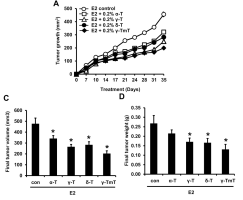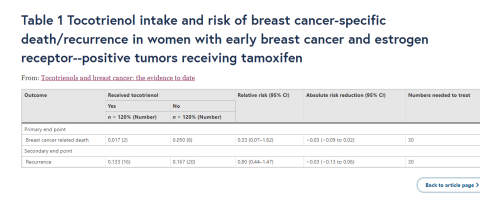estrogen stimulated breast cancer (desirable effect from alpha, delta, gamma, or gamma mixed tocopherols)

 www.ncbi.nlm.nih.gov
www.ncbi.nlm.nih.gov
0.2% of diet (>1g tocopherol human?) alpha slowed estrogen cancer, gamma and delta performed better.
but mixed tocopherols high in gamma performed the best (y-TmT).

estrogen stimulated breast cancer #2 (big undesirable effect from DL-a-tocopherol acetate)

with lung tumors
(big desirable effect from Alpha tocopherol succinate)
 aacrjournals.org
aacrjournals.org

Mechanism is the succinate form works by inhibiting ubiquinol at complex II in mitochondria.
Human cancers tend to still have complex II intact.
so with this the mitochondria builds up ROS which causes apoptosis / cell death. its different to usual vitamin E
So I wondered if this would cause toxic effects on healthy cells too,
apparently not (or not as much) as the healthy cells can tolerate the extra stress better than tumor cells. so the effect is basically selective on cancer in terms of immediate effect
But interfering with complex II probably isn't great over the long term if just using this generally instead of with cancer. looks like a potent option there though
Skin absorption https://iubmb.onlinelibrary.wiley.com/doi/pdf/10.1080/15216549900201543
Through the skin dissolving the powder in oil , ~50% was absorbed & only 6% is converted to tocopherol without the succinate.
So if going by these studies for cancer then alpha tocopherol succinate is likely optimal, followed by mixed tocopherols high in gamma, & dl-alpha tocopherol acetate form could have opposite effects. not sure about dl-alpha
[interestingly on the ray peat emails wiki ray preferred high gamma mixed vs high alpha]
[for general day to day intakes outside of cancer only a low mg amount of vit e is needed for countering pufa. https://www.cambridge.org/core/services/aop-cambridge-core/content/view/S000711451500272X rounding up its 1mg vit e per gram linoleic acid , so even people with high pufa intake don't need the megadoses in supplements
if you look around at foods its rare to find a food with > a couple milligrams. we wouldn't have got anywhere near 100s of milligrams generally. Vit E has a long half life and the body stores it,
But say we want to 2x historic intake when taking into account modern environment higher in toxins, usual supplements are overdosed multiple times higher than that still. these are more for use like a drug treating something, if right form is used. otherwise "smaller" intakes e.g 20mg are significant doses]
 raypeatforum.com
raypeatforum.com
side note i wonder if the mole removal effects ray mentioned for DHEA was actually because of the vit E content (think he used dhea in vit e?). someone here posted a thread showing oral vit E caused their skin tag to drop off in like 10 days & repeated the result.
on a quick look apparently skin tags have more estrogen / androgen receptors A STUDY OF ANDROGEN AND ESTROGEN RECEPTORS α, β IN SKIN TAGS
and study #1 showed alpha tocopherol had mild anti estrogen effects compared to delta / gamma.
wonder if topical mixed high in gamma works well on moles / skin tags?

Inhibitory effects of γ- and δ-tocopherols on estrogen-stimulated breast cancer in vitro and in vivo
Estrogens have been implicated as complete carcinogens for breast and other tissues through mechanisms involving increased cell proliferation, oxidative stress and DNA damage. Because of their potent antioxidant activity and other effects, tocopherols ...
0.2% of diet (>1g tocopherol human?) alpha slowed estrogen cancer, gamma and delta performed better.
but mixed tocopherols high in gamma performed the best (y-TmT).
estrogen stimulated breast cancer #2 (big undesirable effect from DL-a-tocopherol acetate)
Our results showed that the tumors were significantly larger (p<0.05) with 0.1 g/kg and 0.5 g/kg vitamin E supplemented compared with those from the control group
with lung tumors
(big desirable effect from Alpha tocopherol succinate)
Suppression of Tumor Growth In vivo by the Mitocan α-tocopheryl Succinate Requires Respiratory Complex II
Abstract. Purpose: Vitamin E analogues are potent novel anticancer drugs. The purpose of this study was to elucidate the cellular target by which these agents, represented by α-tocopoheryl succinate (α-TOS), suppress tumors in vivo, with the focus on the mitochondrial complex II...
Mechanism is the succinate form works by inhibiting ubiquinol at complex II in mitochondria.
Human cancers tend to still have complex II intact.
so with this the mitochondria builds up ROS which causes apoptosis / cell death. its different to usual vitamin E
Here, we show that the agents, epitomized by the redox-silent α-tocopheryl succinate, suppress progression of carcinomas with functional and reconstituted mitochondrial complex II (CII), whereas tumors with dysfunctional CII are resistant to the drug. Because CII rarely mutates in cancers, it is a promising target of clinical relevance for VE analogues and other, thus far, unidentified agents.
So I wondered if this would cause toxic effects on healthy cells too,
apparently not (or not as much) as the healthy cells can tolerate the extra stress better than tumor cells. so the effect is basically selective on cancer in terms of immediate effect
Here we show that α-TOS preferentially kills malignant cells while showing very limited or no toxicity towards normal cells. These findings are complemented by reports which showed no toxic effect of α-TOS on normal fibroblasts (Jha et al, 1999) or prostate cells (Israel et al, 2000), and by a finding that α-TOS was toxic towards malignant but protective for normal stem cells (Fariss et al, 1994)
In conclusion, our results strongly suggest that α-TOS, a pharmacologically relevant micronutrient without known side-effects(Bendich and Machlin, 1988), is a potent pro-apoptotic agent for avariety of malignant cells, while being non-toxic for normal cells,and warrants testing as an anticancer drug or adjuvant in experimental animal models of tumorigenesis and leukaemia. This notion is further encouraged by recent findings that α-TOS inhibited tumour growth in nude mice with colon-cancer xenografts, similarly or more potently than did other experimental or established anticancer agents (Neuzil et al, 2001; Chinery et al, 1997). Furthermore, free vitamin E or α-tocopheryl acetate, the usual pharmacological form of vitamin E, do not have pro-apoptotic activity (Quian et al, 1997; Neuzil et al, 1999). Hence, our results may have important implications for therapy and prevention of cancer
But interfering with complex II probably isn't great over the long term if just using this generally instead of with cancer. looks like a potent option there though
Skin absorption https://iubmb.onlinelibrary.wiley.com/doi/pdf/10.1080/15216549900201543
Through the skin dissolving the powder in oil , ~50% was absorbed & only 6% is converted to tocopherol without the succinate.
If 58 % of the applied TS was absorbed, and 6 % was converted to free tocopherol, a net body uptake from skin application of 2.2 mg/cm 2 in a human with 18,000 cm 2 skin area would result in (2.2mg/cm2)(0.122)(0.58)(18,000 cm2)(0.06)= 168mg tocopherol/day, approximately five times the Recommended Dietary Allowance of 30mg/day.
So if going by these studies for cancer then alpha tocopherol succinate is likely optimal, followed by mixed tocopherols high in gamma, & dl-alpha tocopherol acetate form could have opposite effects. not sure about dl-alpha
[interestingly on the ray peat emails wiki ray preferred high gamma mixed vs high alpha]
[for general day to day intakes outside of cancer only a low mg amount of vit e is needed for countering pufa. https://www.cambridge.org/core/services/aop-cambridge-core/content/view/S000711451500272X rounding up its 1mg vit e per gram linoleic acid , so even people with high pufa intake don't need the megadoses in supplements
if you look around at foods its rare to find a food with > a couple milligrams. we wouldn't have got anywhere near 100s of milligrams generally. Vit E has a long half life and the body stores it,
But say we want to 2x historic intake when taking into account modern environment higher in toxins, usual supplements are overdosed multiple times higher than that still. these are more for use like a drug treating something, if right form is used. otherwise "smaller" intakes e.g 20mg are significant doses]
Vitamin E succinate decreases melanoma size by 650% in vivo
I have already posted a study about vitamin E succinate (VES) beeing able to decrease liver carcinoma by 77% (Vitamin E Succinate Very Effective Against Liver Carcinoma ,acetate Form Increases It) There have previously been studies on VES and melanoma in vitro and they all showed decreases in...
side note i wonder if the mole removal effects ray mentioned for DHEA was actually because of the vit E content (think he used dhea in vit e?). someone here posted a thread showing oral vit E caused their skin tag to drop off in like 10 days & repeated the result.
on a quick look apparently skin tags have more estrogen / androgen receptors A STUDY OF ANDROGEN AND ESTROGEN RECEPTORS α, β IN SKIN TAGS
and study #1 showed alpha tocopherol had mild anti estrogen effects compared to delta / gamma.
wonder if topical mixed high in gamma works well on moles / skin tags?
Attachments
Last edited:



